In many of the different courses inside The Blues Club, I talk about the importance of targeting the tonic note as a way of completing your phrases.
As I will explain in much more detail below, this works so effectively as it creates a moment of resolution and acts like a musical full stop. And this brings each of your individual licks and phrases to a neat close.
There are however, effective alternatives to this approach. And one of my favourite of these is targeting the 5th at the end of your licks.
Not only will this help you to add variety to your playing, it will also help you to create a distinct Albert King vibe in your solos.
Now, whilst the basic concept of targeting different notes at the end of your phrases might be fairly simple – I am discussing it here in theoretical terms. This is because I am referring to intervals. And I am doing so intentionally.
Understanding how to target different intervals – rather than always thinking in terms of frets – will allow you to move this idea into different keys. It will also help you to better understand why certain notes sound the way they do in any given musical context.
If intervals is a topic with which you don’t yet feel comfortable, then I would recommend heading over to the course ‘An Introduction To Intervals‘ before continuing here. You can also find a shorter introduction to the topic in this article here.
If however you do feel comfortable with intervals, then we can turn our attention to the topic at hand. Here I will cover how targeting the 5th at the end of your phrases differs from targeting the tonic.
I will also provide practical examples of how you can target the 5th in your solos, and move this idea into a variety of different keys.
So without further ado, let’s get into it:
The importance of the tonic
To begin with, I think it is worth recapping what the tonic note is, and the role that it plays when you are improvising.
The tonic note is the tonal centre of the piece of music that you are playing. If you are playing in the key of A, the note of A is the tonic.
This is the note around which everything is centred. And as I will explain below – this has various implications for how the tonic note functions when you play it in your improvisations.
If you are playing in the key of G, the note of G becomes the tonic note. If you are playing in the key of C, the note of C becomes the tonic note. And so on.
In this lesson we will be focusing on the key of A. There are many different notes of A all over the fretboard. Here however we will be taking a more streamlined approach and studying where these tonic notes appear in the first and second shapes of the A minor pentatonic scale. These two scale shapes are as follows:
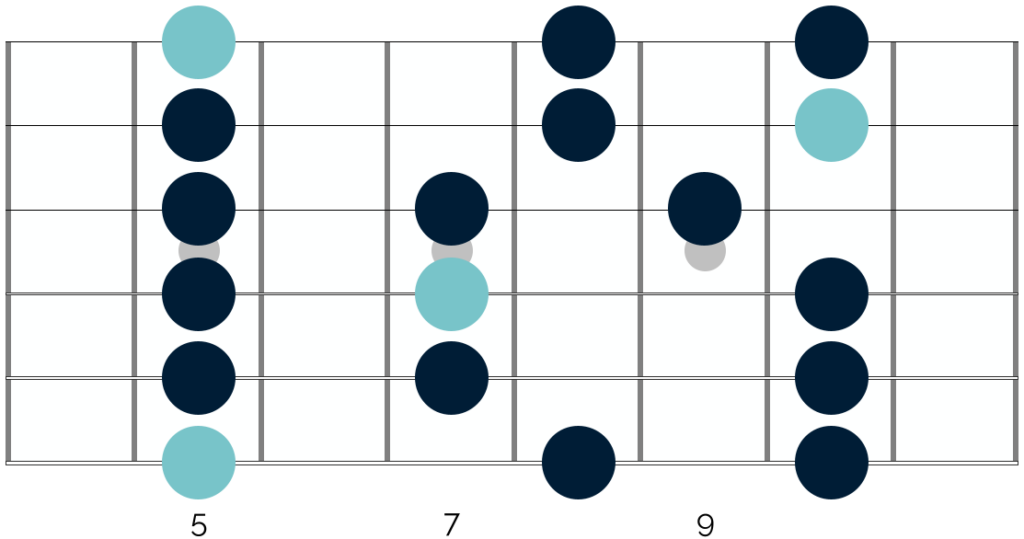
The tonic notes here are highlighted in light blue.
When you play the tonic in your solos, it creates a sound that is totally lacking in tension. It is perfectly resolved. Regardless of the key in which you are playing, your ear draws you back to the tonic. And so when you reach the tonic note, you achieve a moment of musical resolution.
This gives your phrases a feeling of finality. It helps to make your licks more effective and impactful and it puts you into an advantageous position to launch into the next phrase or lick. You can pause in a logical resting point, before then moving onto your next lick.
Effective public speaking – which provides us with a nice parallel for blues guitar soloing – functions in much the same way. A skilled public speaker will make a powerful and impactful statement, pause to let their idea sink in, and then move onto their next phrase.
It is perhaps not surprising then, that targeting the tonic note is something that all blues guitarists do in their playing. Of course they don’t limit their use of it to just finishing off their licks and phrases. But they will often target it in their playing in the way I have described above.
The guitarist arguably most famous for this technique is the King Of The Blues himself, B.B. King. One of King’s signature techniques is targeting the tonic note on the high E string.
This creates the same sense of resolution, whilst putting a slightly different spin on this idea. King also takes a similar idea by going to the high E string and jumping up a whole octave (12 frets) to target a tonic note in a higher register.
You can hear both of these ideas used to brilliant effect in the song ‘The Thrill Is Gone‘. The song is in the key of B minor, and the first note that B.B. King plays is the note of B (at the 7th fret) on his high E string. And that is a note to which he returns at various points during the opening and later solos.
Just before the 4 minute mark King then jumps up to the 19th fret on his high E string to target the tonic note of B an octave higher.
Targeting the 5th
Targeting the tonic note is effective. And taking inspiration from B.B. King and altering how you play the tonic can help you to get much more mileage from the idea. If you’d like more information on how to recreate King’s use of the tonic – then I cover it in much more detail in this dedicated lesson here.
Even if you do adopt this approach though, targeting the tonic note in this way does have its limitations.
Firstly, if you always use it at the end of your phrases, you run the risk of sounding a little repetitive. Secondly, solely adopting this approach has the potential to limit your creativity, as you constantly have to work your way back to the tonic at the end of your licks.
One nice alternative that works very well is to target the 5th at the end of your phrases.
The 5th is an interval that is perfect in quality. Perfect intervals are so called because they sound perfectly consonant.
When played either together or in succession, they do not create any musical tension. Instead they sound totally resolved. This means that like the tonic – targeting the 5th also creates a feeling of resolution at the end of your licks.
When you are playing in any given key, there are 5th intervals all over the fretboard. Again though, here we are going to take a streamlined approach and focus on just the first and second shape of the A minor pentatonic scale:
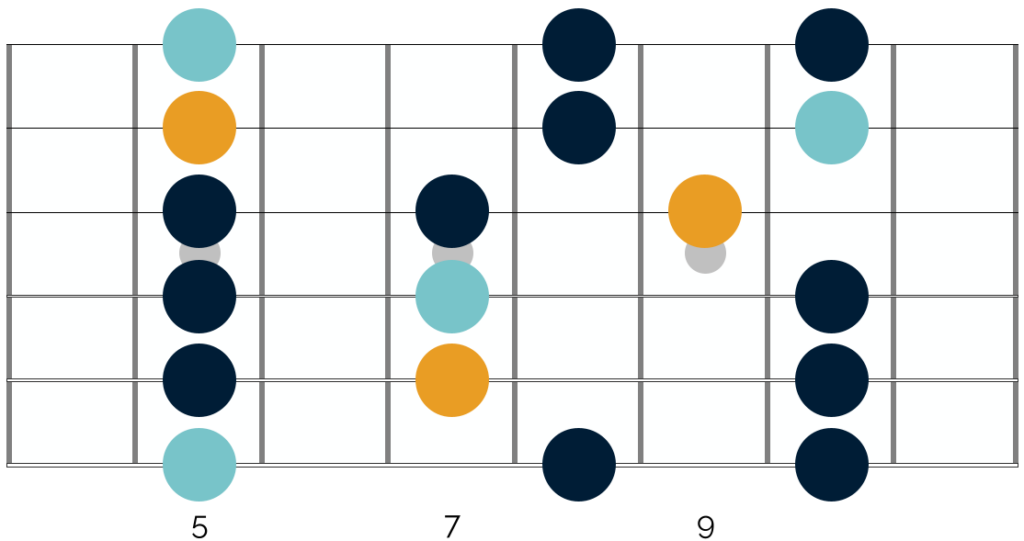
As in the previous diagram, the tonic notes are highlighted in light blue. Now though, the 5th intervals are also highlighted, this time in yellow.
Finding the 5th
In this particular section of the fretboard, there are only 3 notes for you to memorise. However there are two neat connections between the tonic notes and the 5th that will allow you to get to grips with these quickly – and to target them all over your fretboard. These are as follows:
Firstly, on any given string, whenever you find a tonic note, you will find the 5th one string higher (in pitch) and 2 frets higher. This is as follows:

You might recognise this as a familiar power chord shape. And this relationship holds true across the different strings on your guitar, apart from between the G and B strings. As a result of your guitar’s tuning, the difference here is 3 frets, rather than 2. It is instead as follows:
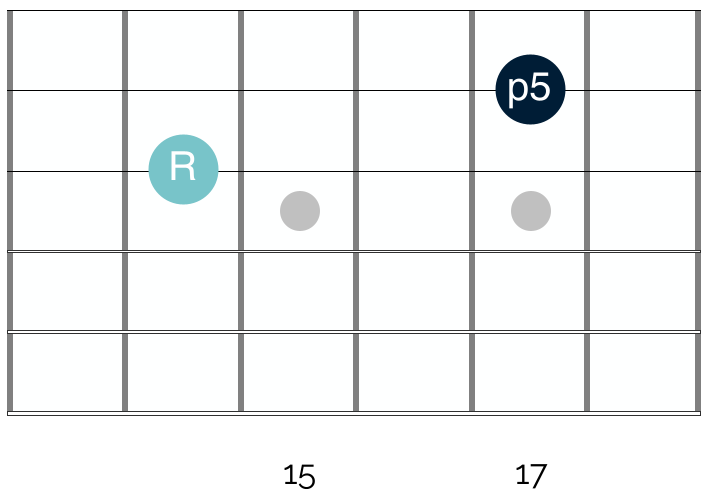
This diagram shows the section of the fretboard you would encounter in the key of A when playing in the fourth and fifth shapes of the minor pentatonic scale. And as you can see, when we move from the G to the B string, the 5th interval is 3 frets higher than the tonic.
The second and closely related connection – or alternative way of looking at the relationship between the tonic and 5th is as follows:
Whenever you find the tonic note, you will find the 5th directly below it – one string lower (in pitch) but on the same fret. We can see this if we return to the examples above and add the additional tonic notes into the diagrams:
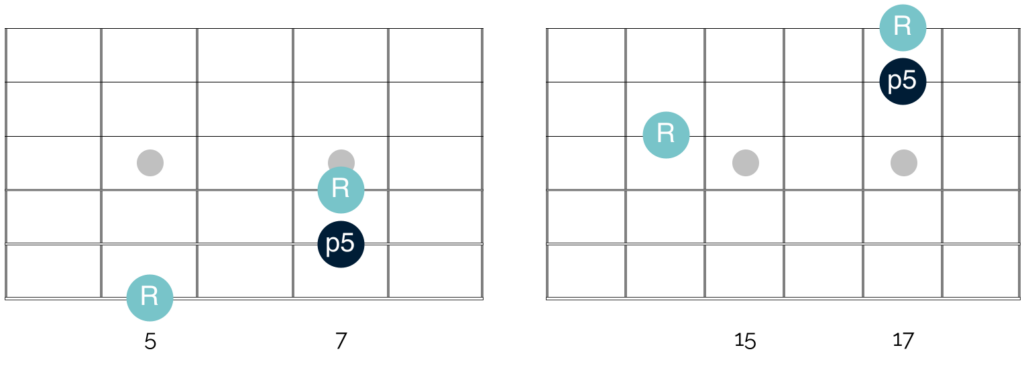
As you can see, the 5th interval always sits directly below the tonic note on almost all strings. This is the specific movement I target in the lick that I play around the 20 second mark of the video and which I have tabbed out below.
The only difference again is between the G and the B string. Here the tonic note sits one fret back on the lower string. This is as follows:
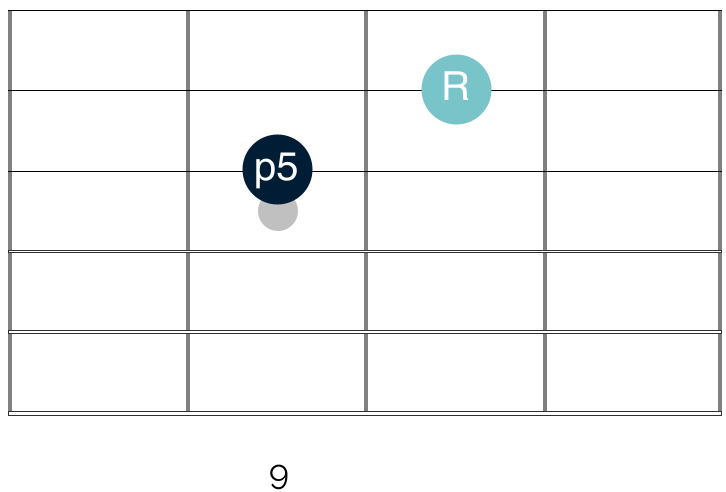
These exceptions between the G and B string can make it a little more challenging to target the 5th on these strings. However hopefully these connections simplify the process of focusing on the 5th and using it in your solos.
The tonic vs. the 5th
Now that we have covered what the 5th is, and how you can find it on the fretboard – we can look at why doing so is beneficial.
In my opinion, there are 3 significant benefits of targeting the 5th in your solos. I have noted the first of these above. And it is simply that the 5th offers a viable alternative to the tonic – helping to keep your solos fresh and interesting.
Beyond that though, in my opinion there are two real benefits.
The first of these is that you can take advantage of the subtle differences between the 5th and the tonic. For whilst both the 5th and the tonic are ‘perfect’ intervals, they do not sound the same.
To explain these differences in purely musical terms can be a little challenging. And so here I think that an analogy can prove helpful.
Soloing and improvising is like taking a journey. You create movement and take your listener from point A to point B.
Within this framework, the tonic note represents the tonal home centre of the piece of music over which you are playing. When you play the tonic note, you return to this home base. It is like arriving home at the end of your journey.
You return back to a place of comfort and safety, knowing you don’t need to leave. Not only does this create a sense of finality, it also represents the greatest level of comfort and resolution possible.
The 5th interval shares many of these same qualities. It is also a place of comfort and safety, however it does not share the same sense of finality. It is more like stopping at your favourite restaurant towards the end of your journey.
You can relax and feel comfortable, but you don’t feel the same as being at home. You know that there is still some portion of your journey remaining. Not only that, but you are unlikely to be as relaxed and comfortable as sitting in a restaurant with other people.
If we bring this back into the world of blues guitar improvisation – the distinction is as follows:
The tonic has a stronger sense of resolution and finality than the 5th. Both sound resolved, but the 5th lacks that complete and settled feel.
If you want to hear this in action, I would recommend comparing these two licks:
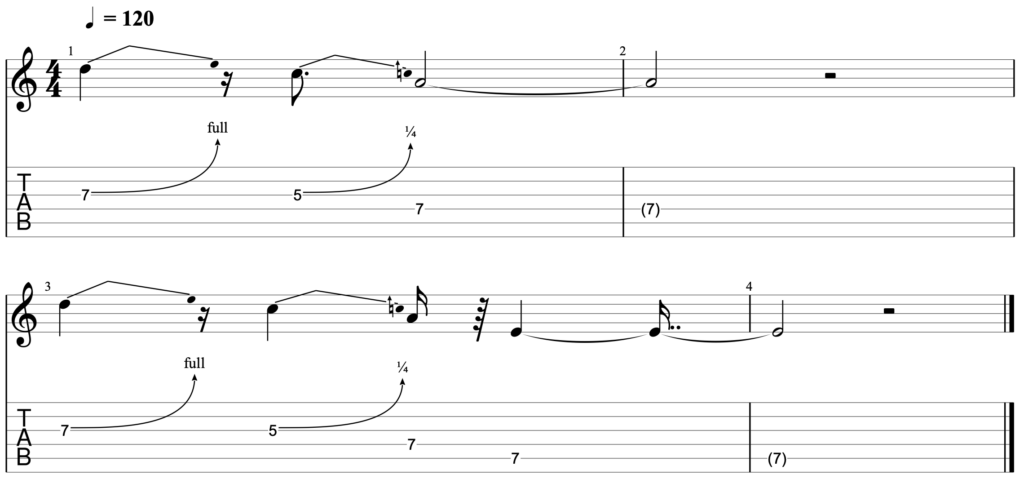
I play these two ideas starting from the 0.19 second mark in the video above. And at a tempo of 120 BPM, this is how these two licks sound:
Played in isolation as in the video above and in this audio clip, you might not notice a big difference between targeting the tonic and 5th. However, once you feel comfortable with these two licks, try them over a variety of A blues backing tracks.
When you do so, hopefully you will be able to hear the subtle difference in feel when you opt to finish your phrases either on the tonic or on the 5th. The former will sound like returning home. The latter will sound resolved, but will create a subtle feeling that it wants to move somewhere,
Bring the blues power!
The last and significant benefit of targeting the 5th in your solos, is that it helps to create an Albert King style vibe in your solos.
Albert King typically targets the 5th interval in his solos. This is because King constructed many of his most famous solos around the top of the second shape of the minor pentatonic scale – an area that has now come to be known as the ‘Albert King Box’. In the key of A this is what the Albert King box looks like:
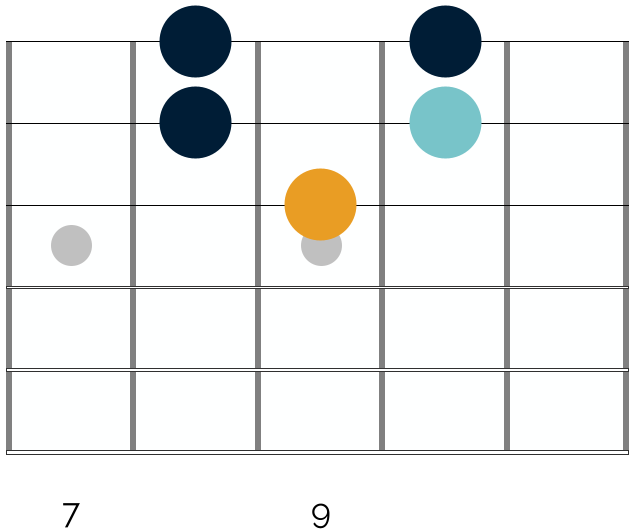
As in previous examples here, the tonic note of A is highlighted in light blue. And the 5th interval is highlighted in yellow.
When using this box shape in his playing, King typically bends the notes on the top strings and then resolves his phrases down to finish on the 5th. You can hear this in a whole range of his songs, including:
So if you want to create a range of different licks and ideas – whilst ‘tipping your hat’ to Albert King, start targeting this shape in your playing. Not only can you use it to target the 5th in your solos; you can also use it to easily compare the sound of the tonic and 5th.
This will help you to create varied and interesting licks. However more significantly it will help you to appreciate the different sound of these notes. This will develop your musical ear and help you to craft more subtle and nuanced blues guitar solos moving forwards.
Next steps
The examples that I have covered here have been focused in a single key. However the benefit of focusing on intervals – rather than on frets – is that you can transpose these ideas into different keys.
If we jump up to the key of B for example, we can see that the tonic notes and 5th intervals are found within the same positions in the scale shapes:
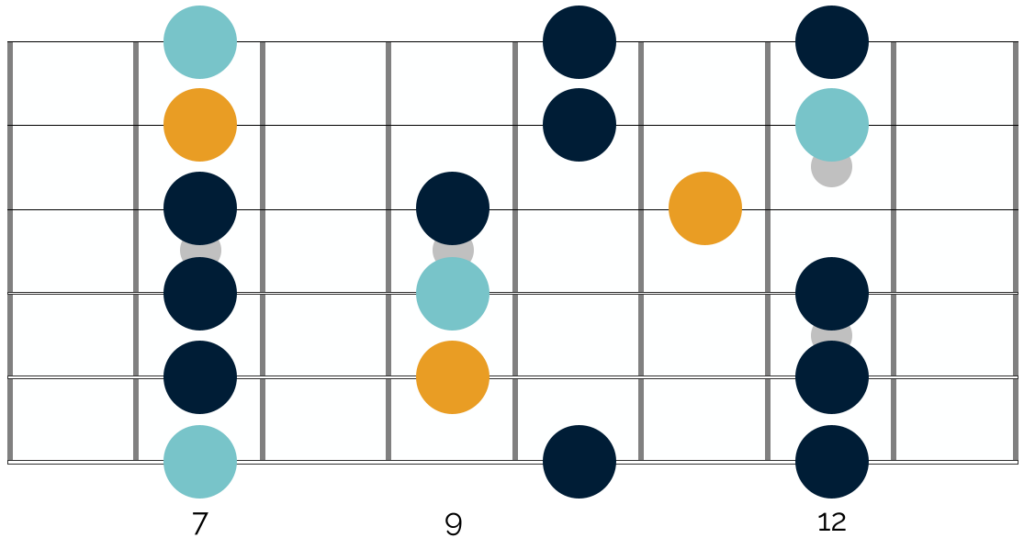
And this is also true when you move into the key of C, G and E etc.
The examples in this lesson have also been focused predominantly in the first and second shapes of the minor pentatonic scale. However we can of course extend this to all 5 shapes of the scale. This is where you will find the tonic notes and 5th intervals in the A minor pentatonic scale:

As in previous examples, the tonic notes are highlighted here in light blue. And the 5th intervals are shown in yellow. So, once you feel comfortable targeting these different sounds in your solos in the first and second pentatonic shapes – try moving it out to the remaining shapes.
As you then start to feel confident here, you can move this out to different keys and also to different scales.
Good luck!
And if you want to access all of these weekly tips, as well as full length video courses, unlimited email and messenger support and a further range of resources that will make you a better and more confident blues guitarist, join the Blues Club. You can find out more and get signed up here.
I hope to see you in there! 😁
Image
The image of Albert King is taken from Winston Vargas on Flickr. The Creative Commons licence for the image is here





Responses
A very nice lesson ! L’astuce de la position de la quinte ( 5th) suivant la position de la tonique est vraiment très pratique .
Merci pour la qualité et la continuité de tes tutos . Et comme disait Brownie McGuy : Blues got a baby and all the world say it’s the Rock n’ Roll !!!!!!!!
Merci beaucoup Roland! I am very glad to hear that you found the lesson helpful, and please do let me know if you ever have any questions about this or other lessons. You can reach me on aidan@happybluesman.com and I am always around and happy to help 😁 Thanks again!
Thanks you for this perfect lesson Aidan!
I have been a bass-player for many a year so I know about intervals (I think, or at least I hope 😄) but your lesson has made me understand what these terrific guitar men are trying to accomplish! And, who knows, I will pick up a “real” guitar once in a while and do a thing or two myself …
I look forward to the next lesson. Thank you!
Thank you so much for taking the time to write such a kind comment Han, I really appreciate it and I’m very glad to hear you found it helpful. And best of luck if you do go for the guitar. I have worked with some guitarists who spent many years playing bass beforehand, and man they are always awesome – with a killer sense of rhythm and groove – and normally a very good understanding of theory! 😁